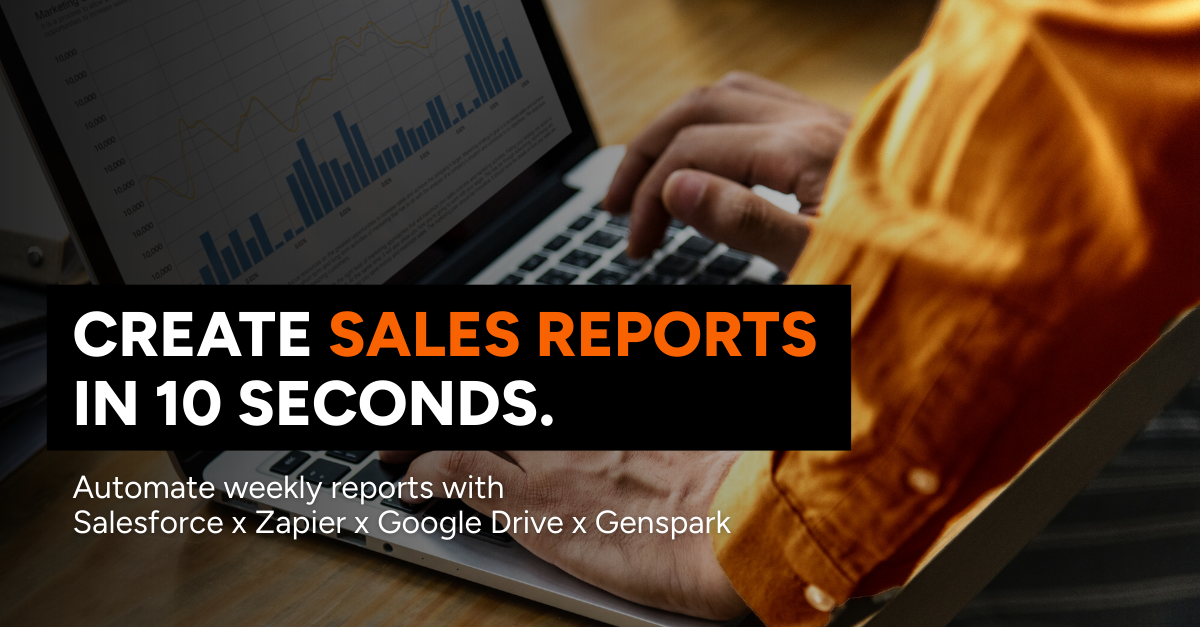We’ve all heard the promise: AI tools that take over the repetitive work, allowing us to focus on strategy. But how close are we really to replacing manual processes like sales reporting? Could AI slides be the turning point that shifts reporting from routine drudgery into instant insight?
That’s what we set out to explore with an experiment combining GenSpark, Salesforce, Zapier, and Google Drive. This resulted in a weekly order-status sales report that takes just ten seconds of human work.
Let’s explore what this means for businesses looking for smarter ways to automate their sales reports.
In This Article, You Will Learn:
-
- Why sales reporting is ripe for automation
-
- How GenSpark differs from traditional BI dashboards
-
- The experiment with GenSpark, Salesforce, Zapier, and Google Drive
-
- The results, challenges, and future potential of AI-driven reporting
-
- Why this experiment matters for the future of enterprise productivity
Why Sales Reporting Needs a Rethink
Weekly sales reports are often a grind: checking CRM dashboards, copying figures, building graphs, and formatting slides. Beyond the time spent, the process leaves room for interpretation bias – numbers filtered by human judgement.
What if reports could be generated automatically, directly from source data, with AI adding both quantitative and qualitative insights?
That’s the question we put to the test through a “nearly fully automated” sales reporting flow.
How We Conducted the Experiment
The flow linked Salesforce, Zapier, Google Drive, and GenSpark’s AI Slides tool.
-
- Zapier pulled negotiation data from Salesforce every Monday morning.
- Data was converted into JSON format using JavaScript (generated by ChatGPT).
- The JSON was saved to a dedicated Google Drive folder and timestamped for accuracy.
- Zapier ran these steps automatically on schedule.
- GenSpark’s AI Slides then read the JSON and built a report in minutes.

The only manual step we took was selecting the file in GenSpark and pasting a pre-set prompt, which was only a ten-second effort.
Where GenSpark Made the Difference
Unlike dashboards, which simply project numbers in charts, GenSpark’s AI Slides went a step further by adding context and clarity. Instead of raw figures alone, it produced insights that teams could act upon.
The slides included year-on-year comparisons and monthly trends, making it easy to see progress at a glance. They also offered order breakdowns by topic, client, and deal size, allowing managers to spot where growth was coming from and where attention might be needed. GenSpark also provided a clear and concise commentary that summarised the overall state of play – something no static dashboard could achieve on its own.
The output was a one-page report capturing key KPIs with accuracy, speed, and objectivity. Since the figures were linked directly to Salesforce data, errors and arbitrariness were eliminated.
Insights Behind The Difficulties
Here are the challenges we uncovered during the automation experiment — though in practice, they felt more like minor speed bumps than lasting roadblocks.
1. Prompt Design
Creating prompts that clearly conveyed the intent behind GenSpark’s AI slides took considerable trial and error. The layout of the sales report covering comparisons, graphs, and even colour tones, had to be described in detail. Each JSON data item also needed clear definitions so the AI could interpret and present them correctly.
2. Data Extraction
Choosing which fields to pull from Salesforce was another challenge. This experiment kept to essential items, but in real-world use, deciding on the right level of detail can become complex. The more granular the information required, the more intricate the extraction process becomes.
3. Generative AI Quirks
GenSpark’s slide generation is powerful but not flawless. Graphs sometimes appeared in unexpected formats, and overlaps between text and figures occasionally occurred. While refining prompts can solve many of these issues, it also requires an understanding of the AI’s quirks and the ability to guide it with precision.
4. Manual Triggers
At present, slide generation still involves a manual step. GenSpark cannot yet be triggered by Zapier, nor can it automatically export to Google Slides or PowerPoint. Once this final gap closes, however, fully automated reporting will become possible.
Why This Matters for the Future of Work
The experiment did more than just make our meetings more efficient; it revealed a potential shift in how we approach them as a whole.
If AI can generate accurate, unbiased reports in seconds, then meetings become less about reviewing known data and more about real-time interpretation and decision-making. The productivity test will not be whether AI can make reports – but how teams use them to spark action.
What’s Next for Automated Reporting
It feels like only a matter of time before Zapier triggers GenSpark and slides readily show up in PowerPoint or Google Slides. As data pipelines become smoother and AI tools more agentic, the dream of hands-off reporting will be within reach.
For Clickr, this is only the first step. Future experiments will explore richer datasets, deeper AI commentary, and broader use cases across business functions.
Unlock New Ways to Work with GenSpark
Our experiment showed how reporting can evolve from repetitive work into fast, accurate, and actionable insight. As AI tools like GenSpark mature, the possibilities extend far beyond weekly sales reports, toward a future where routine processes give way to deeper analysis and smarter decisions.
At Clickr, we see this as just the beginning. By combining automation with intelligence, we help businesses move from manual tasks to meaningful growth. If you’re exploring AI-powered reporting, we’re here to help you take the next step.
Talk to us and let’s kickstart a new chapter in enterprise productivity together!



